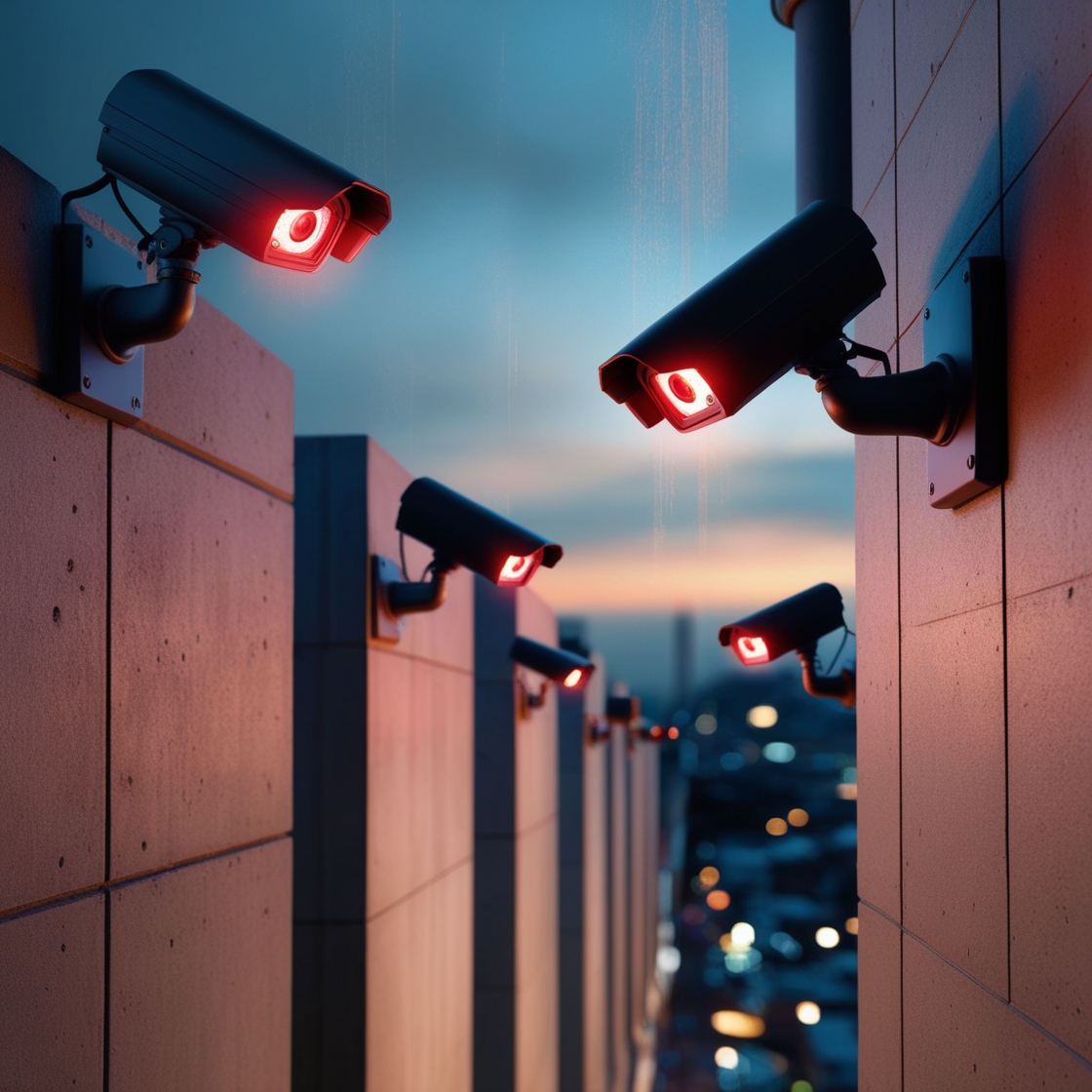Introduction
This is the modern age where security has topped the list of demands today, and so much so in that light. So much has evolved in technological input in the field-from the use of infrared cameras on CCTVs to the existence of efficient, high-quality recordings even in the presence of poor light or complete absence. The rest of this book discusses what infrared CCTV cameras entail in their operation, merits, and shortcomings in delivering to all their prospects.
Understanding Infrared CCTV Cameras
Infrared CCTV cameras are designed for day and night operation. In daylight time, they work like general cameras as they capture pictures in visible light only; as night falls, in decreased levels of light, they will change into the infrared. Infrared LEDs are small diodes integrated into a camera. It emits infrared, which can’t be seen by the human naked eye but will be captured by the camera’s sensor. Thus, it provides clear images in complete darkness.
Essential Components of an Infrared CCTV Camera
- Infrared LEDs: These are a must-have in any infrared CCTV camera because they emit infrared light, thus illuminating the scene for the camera to see.
- Image Sensor: The reflected infrared light coming off the objects is captured by the camera’s image sensor and sent back the image.
- Lens: The light focus falls onto the image sensor using a lens.
- IR Cut Filter: It is essential during the day because it blocks infrared lighting to the sensor. Therefore, it does not affect color balance in images taken during the day. Under low illumination, it leaves its position to allow infrared lighting to the sensor.
Features and Specifications
Infrared CCTV cameras include perfect and effortless features. Since these features will be well understood, one can find an appropriate camera with features that meet the criteria of the application intended to be used with the cameras.
| Feature | Description |
| Night Vision Range | Infrared CCTV cameras can have night vision ranges from 30 feet to over 300 feet, depending on the number and power of the infrared LEDs. |
| Resolution | These cameras can offer resolutions up to 4K Ultra HD, providing clear and detailed images. Lower resolutions, like 1080p or 720p, are also available and might be sufficient for many applications. |
| Weatherproof Rating | Most outdoor infrared CCTV cameras are weatherproof with ratings like IP66 or IP67, meaning they can withstand dust and heavy rain. |
| Motion Detection | Many models feature advanced motion detection algorithms that trigger recording or alerts only when motion is detected, saving storage space and ensuring relevant footage is captured. |
| Connectivity | Infrared CCTV cameras are available in both wired and wireless configurations, offering flexibility in installation. |
| Storage Options | Footage can be stored on DVRs, NVRs, SD cards, or cloud storage, depending on the system setup and requirements. |
Detailed Overview of Features
Night Vision Range
The night vision range varies from the number of infrared LEDs, the power, and an image sensor’s sensitivity. Cameras with many higher-power LEDs and a sensitive image sensor can illuminate and capture an image at considerable distances. For instance, a professional model camera can illuminate up to 300 feet in total darkness; however, a standard model may only go as far as 100 feet.
Resolution
High-resolution cameras can very well be defined with a high-quality image, and the details of reading the license plates and faces are an essential feature where they should be read clearly. The highest grade for consumer surveillance cameras is 4K Ultra HD. The second-best grade in terms of resolution is 1080p or Full HD, and the third-grade resolution is 720p or HD. The high-grade resolution demands as much space and bandwidth as much as it needs while transmitting. So, the resolution goes along with what resources are available.
Weatherproof Rating
IP rating on cameras refers to its weather resistance rating. An IP66-rated camera, for example, is dust-tight with powerful water jets. A rating of IP67 means that it is dust-tight but can be submerged in water at a certain depth of up to 1m for a short period. The ratings apply to nearly all outdoor cameras whose deployment is prone to constantly and differently changing weather conditions.
Motion detection
Advanced motion detection means the camera only records images of interest, thus saving storage and making skimming through easier. Some cameras offer an optional customizable motion zone; you can specify which areas in the camera’s field of view deserve a motion alert.
Connectivity
Infrared CCTV cameras are either wired or wireless. The wired cameras are generally connected using Ethernet cables, which also power the camera, known as Power over Ethernet, or PoE. The wireless cameras connect to a Wi-Fi network and are more flexible in their installation but demand a strong wireless signal and a reliable power source.
Storage Options
Many storages have different benefits. DVRs and NVRs can store much data directly on the recorder, so they are suitable for mass deployments. SD cards provide ease and simplicity of installation while storing footage directly on the camera. However, it only holds a limited amount. Cloud storage offers access through the internet and scaling possibilities but requires a subscription and good internet.
Facts and Figures
Installation Rate: More than 60% of infrared CCTV cameras are installed in new security due to their better night vision.
Growth Rate: The CCTV camera market is estimated to grow around 12% annually with improved security awareness and technological improvement.
Price: Infrared CCTV cameras range from $100 for the most basic to $500 or more in the high-end versions for advanced features.
Life Expectancy: Infrared CCTV cameras have a life expectancy of 5 to 7 years under normal conditions. This depends on the environmental conditions and quality of the components.
Infrared LED Life Expectancy: The infrared LEDs in these cameras have a life expectancy of about 20,000 to 50,000 hours of use.
Advantages and Disadvantages
Advantages
Perfect Night Vision: Infrared CCTV cameras produce excellent and clear images in complete darkness, so they are ideal for surveillance 24/7.
High Resolution: Models vary since different cameras come with a high resolution of up to 4K, making videos much clearer.
Weather Proof and Vandal-Resistant: Many infrared CCTV cameras are weather-resistant, which makes them very suitable for use indoors as well as outdoors.
Versatility: All application areas’ suitable cameras are the installation of residential, commercial, and industrial surveillance.
Improved Security: This scares burglars as they soon see that it can also be approached at night.
Advantages
More Expensive: Infrared CCTV cameras are relatively pricey due to all the other additional features.
Much Power Consumption: Many infrared LEDs consume much power with various cameras.
Short Range: Although infrared cameras give clear night vision, the distance would not be as long as the space they can scan during the day.
Risk of Infrared Glare: This method can easily cause glare as infrared light bounces back and may reflect off surfaces near where it was installed, deteriorating the image.
Conclusion
The latest innovation in surveillance equipment, infrared CCTV cameras, offers a high-quality and reliable image in bright light and night. Providing comprehensive security systems is valuable as they work effectively at night. However, costs and power consumption, not the installation process, should be considered to benefit from full use. This would enable users to understand the aspects of their deployment and enhance their security infrastructure wisely.
FAQ’s
Q: Do Infrared CCTV cameras record without any light?
A: No, infrared CCTV cameras use infrared LEDs to illuminate a scene or area so that they can record in complete darkness
Q: How far would it be to see infrared CCTV cameras at nighttime?
A: It largely varies with the model, as high-end cameras can reportedly see up to 300 feet in darkness during nighttime.
Q: Is the majority of infrared CCTV cameras weatherproof?
A: Many infra-red CCTV cameras have ratings such as IP 66 or IP 67, so they are weatherproof and can work satisfactorily outdoors in several climatic conditions.
Q: Does an infrared camera work during the day?
A: Yes. Infrared CCTV cameras make use of visible lights in the daytime. When illumination at the field is low, they take it into the infrared.
Q: Till what time can I run my infrared CCTV camera?
A: Infrared CCTV cameras last 5 to 7 years if maintained well. The infrared LEDs are said to last 20,000 to 50,000 hours.
References
1. SIA Security Industry Association: Information regarding CCTV technology and market trends.
2. Consumer Reports: Reviews and comparisons of the best infrared CCTV cameras.
3. TechRadar: In-depth review of the best CCTV cameras for 2024 performance.
4. Statista: Statistics about the CCTV camera market adoption rate and growth.
5. Security Magazine: Articles on recent advancements and current trends in surveillance technology.

